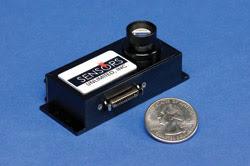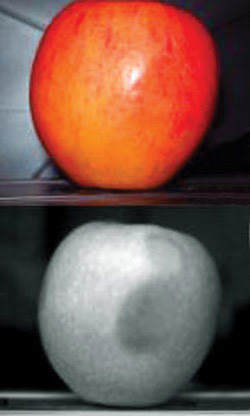Military and industrial applications benefit from InGaAs in the short waveband.
Marshall Cohen, Sensors Unlimited Inc.
Although applications for the mid- and long-wave thermal bands are well-established, short-wavelength infrared holds great promise for military and commercial imaging applications. But we have work to do.
The short-wavelength IR (900 to 1700 nm) has a lot going for it. You can see and image objects that are invisible in other wavebands — from defects in or behind silicon wafers to enemy troop movements at dusk —and do it all using inexpensive glass lenses. The latest short-wave IR cameras are uncooled, have no moving parts and need no peripheral equipment, resulting in reduced size, weight and cost, and improved reliability. And some of the cameras come factory-set, eliminating the need to modify the nonuniformity correction tables in the field.
The InGaAs advantage
The InGaAs technology used in today’s short-wave IR cameras makes the more exciting advances possible because InGaAs detectors are the only ones that work at ambient temperature, resolving all the bulk, weight, expense and reliability issues tied to cooling. Sensors Unlimited Inc. of Princeton, N.J., recently demonstrated a microcamera that’s no bigger than a cigarette lighter (Figure 1). Moreover, work is under way to extend the InGaAs range to 2500 nm, the traditional near-infrared region. This opens up a variety of applications, both industrial and military. InGaAs is truly the enabling technology for short-wave IR.

Figure 1. This microcamera was developed for military applications such as covert surveillance and navigation, especially on unmanned drones where space and weight become issues.
The challenges, however, are many. In passive (existing light) short-wave IR imaging, more laboratory successes must be translated into full-scale volume applications. This technology is ready to solve a broad array of industrial machine vision problems that thermal and visible imaging cannot.
In active (artificially illuminated) short-wave IR imaging, the challenge lies in developing larger-area avalanche photodiodes — critical to the success of several covert surveillance technologies, notably range gating and imaging radar.
And why not eye-safe lasers for the military? Older 1060-nm lasers can blind friends as well as foes, and they are discernible with silicon detectors and night-vision goggles. Now, however, there are InGaAs PIN and avalanche photodiode arrays and cameras that can detect eye-safe and covert 1.55-μm lasers.

Figure 2. A short-wave IR camera captured an image of internal bruises on an apple moving down the processing line.
Short-wave IR imaging — in particular, InGaAs-based — is a proven, maturing technology with a lot of room to grow. In military applications, it will likely emerge as a complement to thermal imaging. In the industrial sector, it will be largely a matter of moving up from near-IR spectroscopy to much faster and more informative short-wave IR imaging for better yields and process control (Figure 2).
Meet the author
Marshall Cohen is CEO of Sensors Unlimited Inc. in Princeton, N.J.; e-mail: [email protected].